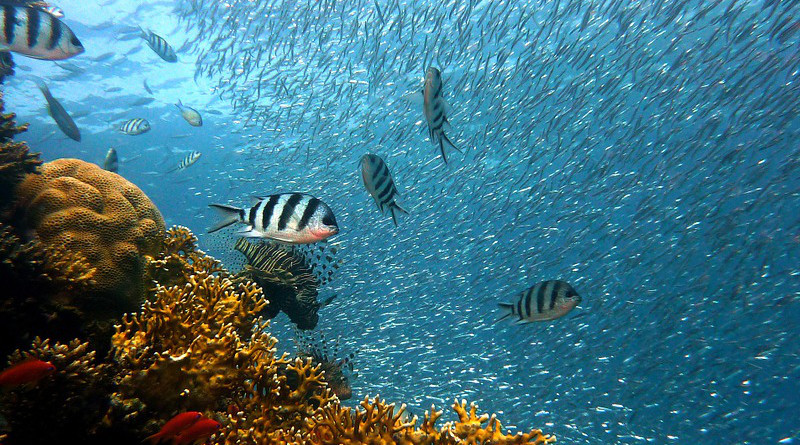Exact Climate Data From The Past
Corals precipitate their calcareous skeletons (calcium carbonate) from seawater. Over thousands of years, vast coral reefs form due to the deposition of this calcium carbonate. During precipitation, corals prefer carbonate groups containing specific variants of oxygen (chemical symbol: O). For example, the lower the water temperature, the higher the abundance of a heavy oxygen variant, known as isotope 18O, within the precipitated carbonate. Unfortunately, the 18O abundance of the seawater also influences the abundance of 18O in the calcium carbonate – and the contribution of 18O from seawater cannot be resolved when determining temperatures based on carbonate 18O abundances alone.
A great step forward was the discovery that the isotopic composition of the precipitated carbonate allows temperature determinations independent of the composition of the water if the abundance of a specific, very rare carbonate group is measured. This carbonate group contains two heavy isotopes, a heavy carbon isotope (13C) and a heavy oxygen isotope (18O) which are referred to as “clumped isotopes”. Clumped isotopes are more abundant at lower temperatures.
However, even with this method there was still a problem: The mineralization process itself can affect the incorporation of heavy isotopes in the calcium carbonate (kinetic effects). If unidentified, the bias introduced by such kinetic effects leads to inaccurate temperature determinations. This particularly applies for climatic archives like corals and cave carbonates.
An international research group led by Professor Jens Fiebig at the Department of Geosciences at Goethe University Frankfurt has now found a solution to this problem. They have developed a highly sensitive method by which – in addition to the carbonate group containing 13C and 18O – the abundance of another, even rarer carbonate group can be determined with very high precision. This group also contains two heavy isotopes, namely two heavy oxygen isotopes (18O).
If the theoretical abundances of these two rare carbonate groups are plotted against each other in a graph, the influence of the temperature is represented by a straight line. If, for a given sample, the measured abundances of the two heavy carbonate groups produce a point away from the straight line, this deviation is due to the influence of the mineralization process.
David Bajnai, Fiebig’s former PhD student, applied this method to various climatic archives. Among others, he examined various coral species, cave carbonates and the fossil skeleton of a squid-like cephalopod (belemnite).
Today, Dr. Bajnai is a post-doctoral researcher at the University of Cologne. He explains: “We were able to show that – in addition to temperature – the mechanisms of mineralization also greatly affect the composition of many of the carbonates that we examined. In the case of cave carbonates and corals, the observed deviations from the exclusive temperature control confirm model calculations of the respective mineralization processes conducted by Dr. Weifu Guo, our collaborator at the Woods Hole Oceanographic Institution in the USA. The new method, for the first time, makes it possible to quantitatively assess the influence of the mineralization process itself. This way, the exact temperature of carbonate formation can be determined.”
Professor Jens Fiebig is convinced that the new method holds great potential: “We will further validate our new method and identify climatic archives that are particularly suitable for an accurate and highly precise reconstruction of past Earth surface temperatures. We also intend to use our method to study the effect that anthropogenic ocean acidification has on carbonate mineralization, for instance in corals. The new method might even allow us to estimate the pH values of earlier oceans.” If all this succeeds, the reconstruction of environmental conditions that prevailed throughout Earth’s history could be greatly improved, he adds.

